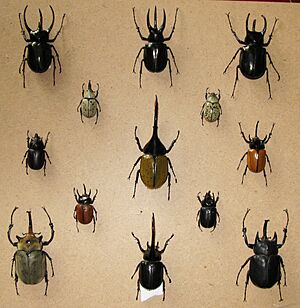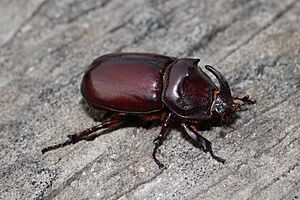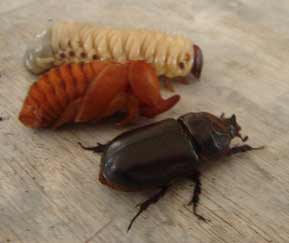Dynastinae facts for kids
Quick facts for kids Dynastinae |
|
|---|---|
 |
|
| Scientific classification |
|
| Kingdom: | Animalia |
| Phylum: | Arthropoda |
| Class: | Insecta |
| Order: | Coleoptera |
| Family: | Scarabaeidae |
| Subfamily: | Dynastinae MacLeay, 1819 |
| Tribes | |
|
See text |
|
Rhinoceros beetles, also known as Dynastinae, are a group of large and strong beetles. They belong to the scarab beetle family. You might also hear them called Hercules beetles, unicorn beetles, or horn beetles. There are more than 1,500 different kinds, or species, of rhinoceros beetles known around the world.
Many rhinoceros beetles are famous for their unique shapes and impressive size. Some well-known types include the Atlas beetle, elephant beetle, and the mighty Hercules beetle. The Japanese rhinoceros beetle, also called kabutomushi, is another popular one. These amazing insects are completely harmless to humans because they cannot bite or sting.
Contents
Amazing Features of Rhinoceros Beetles
Rhinoceros beetles are some of the biggest beetles on Earth. Some can grow longer than 15 centimeters! Even though they look tough, they are completely safe for humans. It's even said that some can lift up to 850 times their own weight!
These beetles get their name from the horns that most males have. They usually have one horn on their head and another pointing forward from their body. Males use these horns to fight other males. They also use them for digging in the ground. The size of a male's horns can show how healthy and well-fed he is.
An adult rhinoceros beetle has a strong, thick outer shell called an exoskeleton. This shell protects its body. They have two sets of wings. The top pair is thick, and underneath are thinner wings for flying. Even though they are big, they can fly, but not always very gracefully!
Their large size helps protect them from animals that might want to eat them. They are also nocturnal, meaning they are active at night. During the day, they hide under logs or in plants. This helps them blend in, or camouflage, to stay safe. If you disturb a rhinoceros beetle, some can make a loud, hissing sound. They do this by rubbing their body against their wing covers.
Life Cycle and Habits
The life of a rhinoceros beetle starts as an egg. From the egg, a larva hatches. These larvae can live for several years, growing bigger by eating rotten wood. After the larval stage, they change into pupae. Finally, they become adult beetles. Adult rhinoceros beetles enjoy eating nectar, plant sap, and fruit.
Reproduction and Competition
Male Japanese rhinoceros beetles often compete for the best feeding spots, especially where there is tasty plant sap. They use their strong horns to push other males away from these areas. Winning these contests can help them find a female beetle. Generally, bigger males with larger horns win more fights. Smaller males might try to avoid bigger rivals and find other ways to meet females.
Rhinoceros Beetles and People
While most rhinoceros beetles are harmless, some can cause problems. For example, the coconut rhinoceros beetle can be a pest in tree farms. Usually, these beetles prefer trees that are already sick or dying. However, if there are many of them, their larvae can sometimes damage healthy trees or even root vegetables. Scientists use a special fungus called Metarhizium majus to help control these beetles in crops.
Pets and Contests
In some parts of Asia, rhinoceros beetles are popular pets. They are clean, easy to care for, and safe to hold. Male beetles are also sometimes used in friendly contests. Because males naturally like to compete, they are chosen for these events. Sometimes, a female beetle or a special sound is used to encourage the males to interact.
A Future Food Source?
Some scientists, like entomologist Séverin Tchibozo, believe rhinoceros beetle larvae could be an important food source. They suggest the larvae have a lot of protein (about 40%), even more than chicken or beef. This could help feed many people in the future.
Inspiration for Science
Rhinoceros beetles are also inspiring scientists! Dr. MinJun Kim and his team have studied how the Japanese rhinoceros beetle flies. They are learning about its body and how it moves through the air. This research could help design new and better aircraft in the future.
Images for kids









